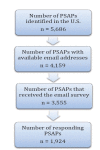Telephone CPR Instructions in Emergency Dispatch Systems: Qualitative Survey of 911 Call Centers
- PMID: 26587099
- PMCID: PMC4644043
- DOI: 10.5811/westjem.2015.6.26058
Telephone CPR Instructions in Emergency Dispatch Systems: Qualitative Survey of 911 Call Centers
Abstract
Introduction: Out-of-hospital cardiac arrest (OHCA) is a leading cause of death. The 2010 American Heart Association Emergency Cardiovascular Care (ECC) Guidelines recognize emergency dispatch as an integral component of emergency medical service response to OHCA and call for all dispatchers to be trained to provide telephone cardiopulmonary resuscitation (T-CPR) pre-arrival instructions. To begin to measure and improve this critical intervention, this study describes a nationwide survey of public safety answering points (PSAPs) focusing on the current practices and resources available to provide T-CPR to callers with the overall goal of improving survival from OHCA.
Methods: We conducted this survey in 2010, identifying 5,686 PSAPs; 3,555 had valid e-mail addresses and were contacted. Each received a preliminary e-mail announcing the survey, an e-mail with a link to the survey, and up to three follow-up e-mails for non-responders. The survey contained 23 primary questions with sub-questions depending on the response selected.
Results: Of the 5,686 identified PSAPs in the United States, 3,555 (63%) received the survey, with 1,924/3,555 (54%) responding. Nearly all were public agencies (n=1,888, 98%). Eight hundred seventy-eight (46%) responding agencies reported that they provide no instructions for medical emergencies, and 273 (14%) reported that they are unable to transfer callers to another facility to provide T-CPR. Of the 1,924 respondents, 975 (51%) reported that they provide pre-arrival instructions for OHCA: 67 (3%) provide compression-only CPR instructions, 699 (36%) reported traditional CPR instructions (chest compressions with rescue breathing), 166 (9%) reported some other instructions incorporating ventilations and compressions, and 92 (5%) did not specify the type of instructions provided. A validation follow up showed no substantial difference in the provision of instructions for OHCA by non-responders to the survey.
Conclusion: This is the first large-scale, nationwide assessment of the practices of PSAPs in the United States regarding T-CPR for OHCA. These data showing that nearly half of the nation's PSAPs do not provide T-CPR for OHCA, and very few PSAPs provide compression-only instructions, suggest that there is significant potential to improve the implementation of this critical link in the chain of survival for OHCA.
Figures



References
-
- Berdowski J, Berg RA, Tijssen JG, et al. Global incidences of out-of-hospital cardiac arrest and survival rates: Systematic review of 67 prospective studies. Resuscitation. 2010;81(11):1479–87. - PubMed
-
- Travers AH, Rea TD, Bobrow BJ, et al. Part 4: CPR overview: 2010 american heart association guidelines for cardiopulmonary resuscitation and emergency cardiovascular care. Circulation. 2010;122(18 Suppl 3):S676–84. - PubMed
-
- Herlitz J, Svensson L, Holmberg S, et al. Efficacy of bystander CPR: Intervention by lay people and by health care professionals. Resuscitation. 2005;66(3):291–5. - PubMed
-
- McNally B, Robb R, Mehta M, et al. Out-of-hospital cardiac arrest surveillance - Cardiac Arrest Registry to Enhance Survival (CARES), United States, October 1, 2005-December 31, 2010. MMWR Surveill Summ. 2011;60(8):1–19. - PubMed
Publication types
MeSH terms
LinkOut - more resources
Full Text Sources
Other Literature Sources
Medical
Miscellaneous

